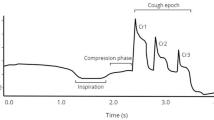Abstract
The Urge-to-Cough is a component of the brain motivation system that mediates cognitive responses to cough stimuli. There are six stages to the cough motivation-to-action system: (1) stimulus, the trigger for the neural event; (2) urge, the physical need to respond to the stimulus; (3) desire, translation of urge into a central neural targeted goal; (4) action, physical response that satisfies the urge-desire; (5) evidence, feedback to the neural system on the action; (6) reward, sensory system that determines if the urge was satisfied. Urge-to-Cough is related to three fundamental types of cough: (1) reflex cough, (2) voluntary cough, and (3) behavioral cough. Urge-to-Cough with reflex cough can be studied by measuring the sensations elicited by a cough stimulus. Neural processes with voluntary cough can be studied using magnitude production cognitive psychometric methods. Results of these studies have shown if the subjects can reliably estimate their Urge-to-Cough, the urge increases with increasing cough stimulus, there is a correlation between the Urge-to-Cough and cough intensity, there is a threshold for eliciting the sensation of the urge that precedes the motor cough behavior, subjects can voluntarily produce coughs of varying magnitudes, the motor cough pattern is directly related to the perceived magnitude of a cough, volitional triggers of a cough are directly related to the reflex cough pattern, and neural triggers of cough initiate a stereotypic motor output. Understanding the Urge-to-Cough motivation-to-action system opens new strategies for research on central neural cough mechanisms.

Similar content being viewed by others
References
Davenport PW, Sapienza CM, Bolser DC (2002) Psychophysical assessment of the Urge-to-Cough. Eur Respir Rev 12(85):249–253
Davenport PW, Bolser DC, Vickroy T, Berry R, Martin AD, Hey JA, Danzig M (2007) The effect of codeine on the urge-to-cough response to inhaled capsaicin. Pulm Pharmacol Ther 20(4):338–346
Vovk A, Bolser DC, Hey JA, Danzig M, Vickroy T, Berry R, Martin AD, Davenport PW (2007) Capsaicin exposure elicits complex airway defensive motor patterns in normal humans in a concentration dependent manner. Pulm Pharmacol Ther 20(4):423–432
Bradley MM (2000) Emotion and motivation. In: Cacioppo JT, Tassinary LG, Bernston GG (eds), Handbook of Psychophysiology, 2nd ed. New York: Cambridge University Press, pp 602–642
Cameron OG (2002) Visceral Sensory Neuroscience:Interoception. New York: Oxford University Press, pp 35–55
Straker D (2002) The Brain’s Urge System. Available at http://www.changingminds.org/explanations/brain/urge_system.htm [accessed 15 March 2007]
Shannon R, Baekey DM, Morris KF, Nuding SC, Segers LS, Lindsey BG (2004) Production of reflex cough by brain stem respiratory networks. Pulm Pharmacol Ther 17(6):369–376
Shannon R, Baekey DM, Morris KF, Li Z, Lindsey BG (2000) Functional connectivity among ventrolateral medullary respiratory neurones and responses during fictive cough in the cat. J Physiol 525 Pt 1:207–224
Bolser DC, Davenport PW (2002) Expiratory motor control during the cough reflex. Eur Respir Rev 12(85):243–248
Ho CY, Gu Q, Lin YS, Lee LY (2001) Sensitivity of vagal afferent endings to chemical irritants in the rat lung. Respir Physiol 127(2–3):113–124
Mazzone SB (2005) An overview of the sensory receptors regulating cough. Cough 1:2
Canning BJ, Mori N, Mazzone SB (2006) Vagal afferent nerves regulating the cough reflex. Respir Physiol Neurobiol 152(3):223–242
Kollarik M, Ru F, Undem BJ (2007) Acid-sensitive vagal sensory pathways and cough. Pulm Pharmacol Ther 20(4):402–411
Dicpinigaitis PV, Dobkin JB (1997) Antitussive effect of the GABA-agonist baclofen. Chest 111(4):996–999
Dicpinigaitis PV, Grimm DR, Lesser M (1999) Cough reflex sensitivity in subjects with cervical spinal cord injury. Am J Respir Crit Care Med 159(5 Pt 1):1660–1662
Dicpinigaitis PV (2003) Short- and long-term reproducibility of capsaicin cough challenge testing. Pulm Pharmacol Ther 16(1):61–65
Dicpinigaitis PV, Rauf K (1998) The influence of gender on cough reflex sensitivity. Chest 113:1319–1321
Sapienza CM, Bolser DC, Schulz GM, Scott K, Davenport PW (1997) Respiratory muscle and airflow pattern during graded voluntary cough in normal subjects. Am J Respir Crit Care Med 155(4):A577
Chiara T, Martin AD, Davenport PW (2006) Expiratory muscle strength training in individuals with multiple sclerosis having mild to moderate disability: effect on maximal respiratory pressures, pulmonary function and maximal voluntary cough. Arch Phys Med Rehabil 87(4):468–473
Mazzone SB, McLennan L, McGovern AE, Egan GF, Farrell MJ (2007) Representation of capsaicin-evoked Urge-to-Cough in the human brain using functional magnetic resonance imaging. Am J Respir Crit Care Med 176(4):327–332
Author information
Authors and Affiliations
Corresponding author
Rights and permissions
About this article
Cite this article
Davenport, P.W. Urge-to-Cough: What Can It Teach Us About Cough?. Lung 186 (Suppl 1), 107–111 (2008). https://doi.org/10.1007/s00408-007-9045-7
Received:
Accepted:
Published:
Issue Date:
DOI: https://doi.org/10.1007/s00408-007-9045-7




